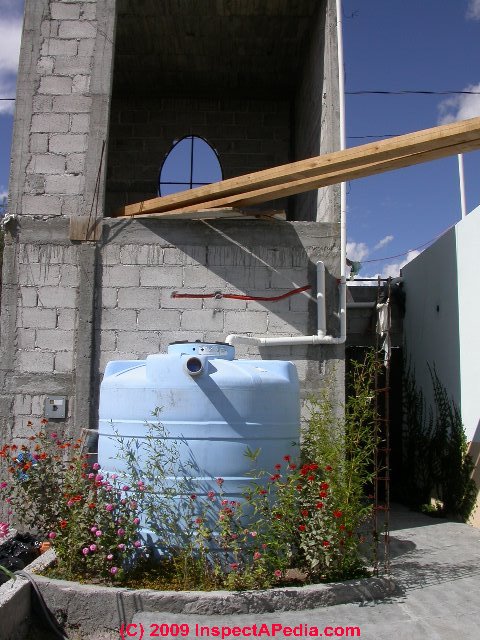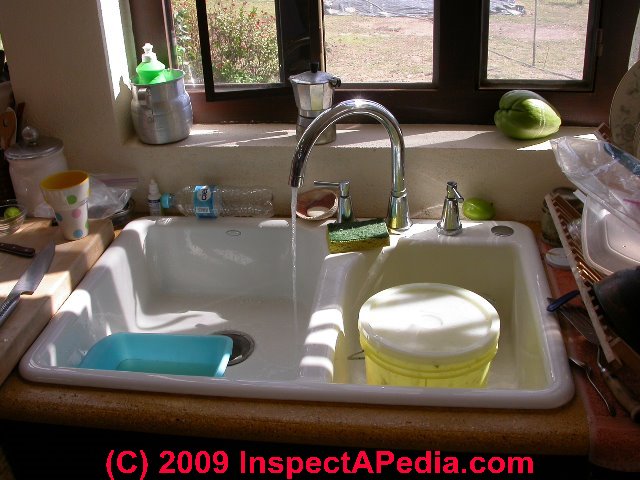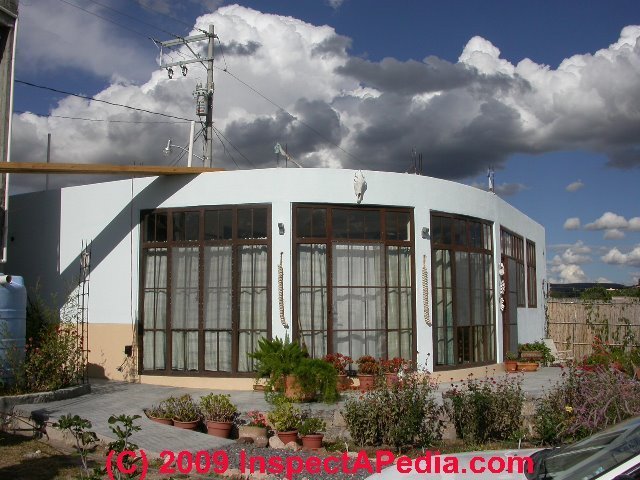 Low-Budget Passive Solar House
Low-Budget Passive Solar House
Design Details
- POST a QUESTION or COMMENT about how to design and build low-cost passive solar homes
This article describes the construction and energy features of a low-budget passive solar home constructed in San Miguel de Allende Mexico.
We describe cost and design trade-offs made by the owner-builder Denise Gelpi Aughtman, a doctor of oriental medicine and acupuncture who practices in Mexico.
The home is functional, occupied, has extremely low operating costs, and like most solar home projects, Aughtman has more improvements in the works.
Our page top photo shows windows admitting morning solar gain in this nearly-balanced-energy passive solar home in San Miguel de Allende, Guanajuato, Mexico.
InspectAPedia tolerates no conflicts of interest. We have no relationship with advertisers, products, or services discussed at this website.
- Daniel Friedman, Publisher/Editor/Author - See WHO ARE WE?
Case Study: a Modest Passive Solar Home Combines Beauty, Low Cost, and Minimum Energy Consumption
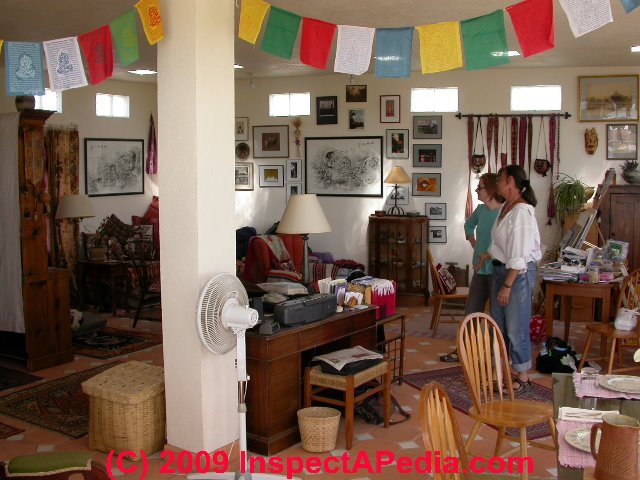 Like many homeowners who are attracted to homes designed to make use of renewable energy, Denise Aughtman, the owner-builder of the home described here could not approach her project with a fat wallet.
Like many homeowners who are attracted to homes designed to make use of renewable energy, Denise Aughtman, the owner-builder of the home described here could not approach her project with a fat wallet.
The modest passive solar design house described in this article provides a real-world example of a working solar home built on a shoestring and operated on a thread.
Sited with a beautiful view [photo] of the mountains above San Miguel de Allende, and located a few kilometers outside of town, this modest home needed to provide shelter, beauty, and economy without breaking the bank.
The passive solar design Aughtman used to lay out and construct the home combines utter simplicity, very low cost, effective solar gains providing light and warmth during cold weather, very efficient use of water and electricity, and the beauty of open space inside the home, and views of the mountains over San Miguel de Allende in central Mexico.
The sense of smallness of the overall size of the home when first viewed from outside is promptly lost on entering the structure.
Aughtman designed a single large room divided into kitchen, dining, living room, work, and sleeping areas by furnishings or bookshelves (photo at left). A single partition wall was constructed to provide privacy for the bathroom.
The structure is designed to permit a later addition of a second story, accessed by a separate stairwell in an attached tower [photo].
Passive Solar Design Simplicity - Thermal Mass
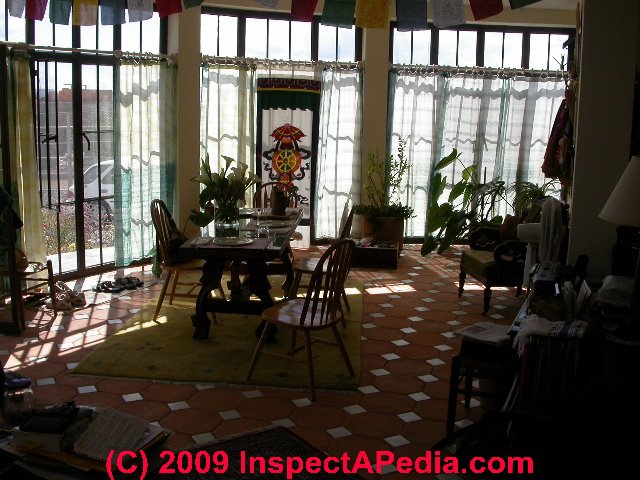 The home is located on a high plain at approximately 6200 ft. in a climate that combines warm daytime temperatures with cool nights.
The home is located on a high plain at approximately 6200 ft. in a climate that combines warm daytime temperatures with cool nights.
Constructed of plastered masonry walls and roof on a poured concrete slab set just above grade, the home's thermal mass absorbs heat during warm hours and returns it to the occupants during chilly mountain nights.
Our weather table below shows that in the climate of this passive solar home, annual average low and high temperatures are 52-77degF. During hot weather, the night-cooled masonry walls and roof help keep the house cool during the day.
During cooler months, passive solar gain to the building's masonry roof and walls provides warmth for nighttime heating.
Adjustment to the amount of solar gain from single-glazed windows around the curved-wall front of the home is provided simply by opening or closing curtains to admit or stop sunshine onto the tiled floor of the building's interior.
Additional lighting for areas of the home most distant from the glass window and door wall are lit by fixed glass glazing in the upper walls
and glass block skylights [photo].
Aughtman's budget did not include radiant floor heating for this passive solar home; she reports that the home is adequately warmed during cool weather by the solar-heated masonry roof, walls, and when needed (open the curtains), the tile floor set directly onto the 6 to 12-inch thick concrete floor slab.
See THERMAL MASS in BUILDINGS for details about using thermal mass for building comfort.
Potable Water Supply & Rainwater Collection at a Passive Solar Home in Mexico
Water supply for home use as well as agriculture is critical in dry climates such as the Southwestern U.S., Mexico (the location of this home) and many other parts of the world.
Our weather table for San Miguel de Allende given below shows that in the climate of this passive solar home, rainfall varies from about 3 mm in the most dry month (February), to 129 mm in the wettest month (June).
While the home is supplied water from a nearby community well, Aughtman elected to make use of several designs to collect rainwater and to make simple use of graywater at her home.
- Basic water supply
to the home is provided from a community well. However because the well is located in an agricultural area where well water is not necessarily potable and , most people drink purified or treated water, either purchasing inexpensive bottled water (20 pesos for a 5-liter container) or installing a water purification system such as a ceramic filter systems.
Watch out: not all water filters remove all hazardous contaminants.
See FILTERS for DRINKING WATER PURIFICATION.
In a separate article at CISTERN & RAINWATER COLLECTION SYSTEMS we describe a rooftop rainwater collection system that sends clean roof runoff into a very large masonry cistern. - Drinking water:
Aughtman treats the incoming community well water with her own colloidal silver solution but in recognition that that method is unreliable for some contaminants
See GIARDIA IN DRINKING WATER and
see COLLOIDAL SILVER WATER PURIFICATION. When budget permits she will install a ceramic filter. Also
see CERAMIC FILTERS & WATER PURIFICATION that can process either water from her community well or rainwater collected in her local cistern (below).
Rainwater is collected from a near-flat rooftop [photo] and channeled to a large fiberglass holding tank - the blue tank in our photograph, (above left).
Piping also permits directing water into this tank from a well-fed cistern located atop the concrete block tower. The tower's height provides water pressure to the building.
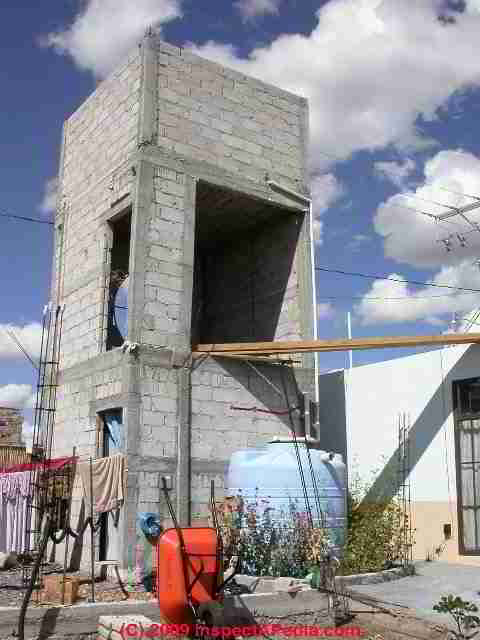
Currently water is taken out of the bottom of this tank by a simple tank drain valve and hose attachment; to supply this water upwards to the building plumbing fixtures or perhaps to the cistern, a small electric pump will be installed.
The tower and a ramp connecting the tower's second floor to a future second story addition on the main house were unfinished at the time of our photograph.
- Graywater is collected from sinks and a shower/tub and used for irrigation, as we discuss and illustrate just below.
Onsite Waste Disposal - Passive Solar Home Septic System in San Miguel de Allende

Graywater
from the kitchen sink and bathroom shower/tub and sink as well as from a laundry [photo] is routed outside to a simple surface channel cut into the soil where it waters ornamental plants, fruit trees, and a vegetable garden.
While a professionally designed graywater system makes use of filtering, Aughtman's budget did not provide for a graywater holding tank, filtration, and a pump.
Instead she makes sure that soaps used in the home are low-nitrate, low phosphate, biodegradable products. Washing machine drainage is passed through a simple external laundry filter to remove lint.
[Note: in the U.S. and many other jurisdictions, discharge of raw graywater to the ground surface is prohibited by local building and sanitation codes.]
See GREYWATER SYSTEMS for design and maintenance details for graywater treatment/disposal systems.

Blackwater, sewage from the home's toilet is routed to a 1000 gallon site-built cesspool located on the property.
The volume of wastewater to be processed is low because of the separation of graywater for onsite irrigation use.
See TANK PUMPING FREQUENCY TABLE for general septic tank pumping frequency; those septic tank cleaning intervals would be significantly extended for this home of a single occupant, occasional guests, and graywater separation.
Watch out: For detailed information including critical safety warnings about cesspools,
see CESSPOOLS.
Composting Food Waste at a Passive Solar Home
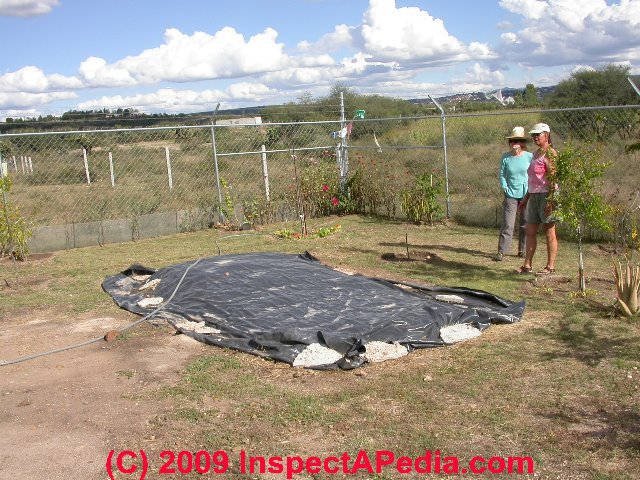
In keeping with the energy conservation and recycling spirit of the Aughtman passive solar home, Denise has included a compost facility in a corner of her property (photo at left).
Because of the seasonally very dry climate in San Miguel de Allende, Aughtman covers the compost pile with plastic to improve its decay-conversion to mulch for use on her vegetable garden, fruit trees, and flowers.
Passive Solar Design for Average Temperatures and Rainfall in San Miguel de Allende, Mexico
Simply put, when outdoor temperatures vary roughly the same amount above and below the human comfort zone (65 deg F to 70 deg F) then in principle, a passive solar home should need almost no additional energy source to provide heating and cooling.
Our table of average weather conditions in San Miguel de Allende (below) shows that in that climate, while daytime highs are not much above the comfort point of 78 deg F, nighttime lows average 26 deg F below that number: solar heating of a thermal mass in the building is wanted for night time indoor comfort.
At THERMAL MASS in BUILDINGS we describe a second home in this climate and we report that its typical morning low temperature in the coldest months falls to about 61 deg F inside that home when no heating source is provided other than the daytime-warmed thermal mass of the building's masonry walls and roof.
Weather Conditions, San Miguel de Allende, Guanajuato, Mexico1 |
|||
|---|---|---|---|
| Temperature Range | Amount Below/Over 78 deg F | Rainfall | |
| January | 44-71 deg F / 7 - 24 deg C | 34/-7 | .5 in / 13 mm |
| February | 46-73 deg F / 9 - 25 deg C | 32/-5 | .1 in / 3 mm |
| March | 49-78 deg F / 11-27 deg C | 29/0 | .2 in / 5 mm |
| April | 54-82 deg F / 12-29 deg C | 24/4 | .8 in / 20 mm |
| May | 57-85 deg F / 14-31 deg C | 21/7 | 1.2 in / 30 mm |
| June | 58-81 deg F / 14-27 deg C | 20/3 | 5.1 in / 129 mm |
| July | 57-78 deg F / 13-24 deg C | 21/0 | 4.7 in / 119 mm |
| August | 57-79 deg F / 13-23 deg C | 21/1 | 4.6 in / 117 mm |
| September | 56-77 deg F / 14-24 deg C | 22/-1 | 4.7 in / 119 mm |
| October | 52-76 deg F / 12-24 deg C | 26/-2 | 4.7 in / 119 mm |
| November | 49-74 deg F / 9-23 deg C | 29/-4 | .6 in / 15 mm |
| December | 46-70 deg F / 8 - 21 deg C | 32/-8 | .4 in / 10 mm |
| Annual Average | 52-77degF | 26 / -1 | |
Notes to the table above
1. Other San Miguel de Allende weather estimates including average high and low temperatures and rainfall vary slightly around these temperature and rainfall estimates.
On average the warmest month in San Miguel de Allende is May, the coolest month in San Miguel de Allende is January, and the wettest month in San Miguel de Allende is July.
...
Continue reading at PASSIVE SOLAR PERFORMANCE PROBE or select a topic from the closely-related articles below, or see the complete ARTICLE INDEX.
Or see these
Recommended Articles
- PASSIVE SOLAR DESIGN HANDBOOK - PDF
- PASSIVE SOLAR DESIGN KEY ELEMENTS
- PASSIVE SOLAR DESIGN METHOD
- PASSIVE SOLAR ENERGY MONITORING
- PASSIVE SOLAR FLOOR TILES, PHASE CHANGE
- PASSIVE SOLAR HEAT PERFORMANCE
- PASSIVE SOLAR PERFORMANCE PROBE
- PASSIVE SOLAR Roof & Window OVERHANGS
- SOLAR ENERGY SYSTEMS - home
- SOLAR HOUSE EVALUATION
- CISTERN & RAINWATER COLLECTION SYSTEMS - combination of rainwater collection and graywater collection, diversion, re-use on a home built in an area of water scarcity.
- DRINKING WATER EMERGENCY PURIFICATION - various methods, including emergency methods for purifying drinking water.
- WATER TREATMENT EQUIPMENT CHOICES
- WEATHER in SAN MIGUEL de ALLENDE - Mexico
Suggested citation for this web page
PASSIVE SOLAR HOME, LOW COST at InspectApedia.com - online encyclopedia of building & environmental inspection, testing, diagnosis, repair, & problem prevention advice.
Or see this
INDEX to RELATED ARTICLES: ARTICLE INDEX to SOLAR ENERGY
Or use the SEARCH BOX found below to Ask a Question or Search InspectApedia
Ask a Question or Search InspectApedia
Questions & answers or comments about how to design and build low-cost passive solar homes
Try the search box just below, or if you prefer, post a question or comment in the Comments box below and we will respond promptly.
Search the InspectApedia website
Note: appearance of your Comment below may be delayed: if your comment contains an image, photograph, web link, or text that looks to the software as if it might be a web link, your posting will appear after it has been approved by a moderator. Apologies for the delay.
Only one image can be added per comment but you can post as many comments, and therefore images, as you like.
You will not receive a notification when a response to your question has been posted.
Please bookmark this page to make it easy for you to check back for our response.
IF above you see "Comment Form is loading comments..." then COMMENT BOX - countable.ca / bawkbox.com IS NOT WORKING.
In any case you are welcome to send an email directly to us at InspectApedia.com at editor@inspectApedia.com
We'll reply to you directly. Please help us help you by noting, in your email, the URL of the InspectApedia page where you wanted to comment.
Citations & References
In addition to any citations in the article above, a full list is available on request.
- Dr. Denise Gelpi Aughtman practices oriental medicine and acupuncture in San Miguel de Allende, Mexico. Dr. Aughtman can be contacted by email: daughtman@gmail.com or by telephone 044 415 113 1043. The passive solar house described in this article is a private home occupied by Dr. Aughtman, but may be available for occasional rental when the owner is traveling.
- PASSIVE SOLAR DESIGN HANDBOOK VOLUME I [PDF], the Passive Solar Handbook Introduction to Passive Solar Concepts, in a version used by the U.S. Air Force
- PASSIVE SOLAR DESIGN HANDBOOK VOLUME II [PDF], the Passive Solar Handbook Comprehensive Planning Guide, in a version used by the U.S. Air Force - online version available at this link and from the USAF also at wbdg.org/ccb/AF/AFH/pshbk_v2.pdf [This is a large PDF file that can take a while to load]
- PASSIVE SOLAR HANDBOOK VOLUME III [PDF], the Passive Solar Handbook Programming Guide, in a version used by the U.S. Air Force - online version available at this link and from the USAF also at wbdg.org/ccb/AF/AFH/pshbk_v3.pdf
- The Passive Solar Design and Construction Handbook, Steven Winter Associates (Author), Michael J. Crosbie (Editor), Wiley & Sons, ISBN 978-047118382 or 0471183083
- "PASSIVE SOLAR HOME DESIGN [PDF] ", U.S. Department of Energy, describes using a home's windows, walls, and floors to collect and store solar energy for winter heating and also rejecting solar heat in warm weather.
- SOLAR WATER HEATERS [PDF] , U.S. Department of Energy article on solar domestic water heaters to generate domestic hot water in buildings, explains how solar water heaters work. Solar heat for swimming pools is also discussed.
- HEAT EXCHANGERS for SOLAR WATER HEATING SYSTEMS [PDF], U.S. DOE describes the types of solar water heater heat exchange methods between the sun and the building's hot water supply
- HEAT-TRANSFER FLUIDS for SOLAR WATER HEATING SYSTEMS [PDF] , U.S. DOE, describes the types of fluids selected to transfer heat between the solar collector and the hot water in storage tanks in a building. These include air, water, water with glycol antifreeze mixtures (needed when using solar hot water systems in freezing climates), hydrocarbon oils, and refrigerants or silicones for heat transfer.
- SOLAR WATER HEATING SYSTEM MAINTENANCE & REPAIR [PDF] , U.S. DOE
- US DOE, SCALING AND CORROSION IN SOLAR WATER HEATING SYSTEMS, U.S. Department of Energy.
- In addition to citations & references found in this article, see the research citations given at the end of the related articles found at our suggested
CONTINUE READING or RECOMMENDED ARTICLES.
- Carson, Dunlop & Associates Ltd., 120 Carlton Street Suite 407, Toronto ON M5A 4K2. Tel: (416) 964-9415 1-800-268-7070 Email: info@carsondunlop.com. Alan Carson is a past president of ASHI, the American Society of Home Inspectors.
Thanks to Alan Carson and Bob Dunlop, for permission for InspectAPedia to use text excerpts from The HOME REFERENCE BOOK - the Encyclopedia of Homes and to use illustrations from The ILLUSTRATED HOME .
Carson Dunlop Associates provides extensive home inspection education and report writing material. In gratitude we provide links to tsome Carson Dunlop Associates products and services.


